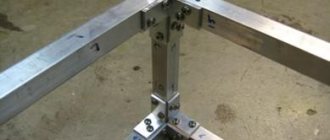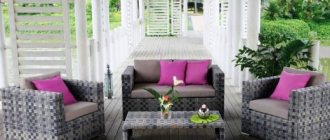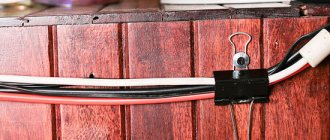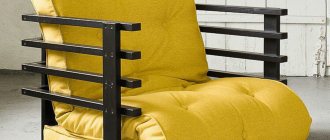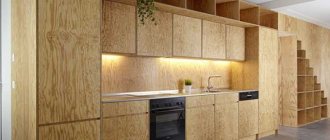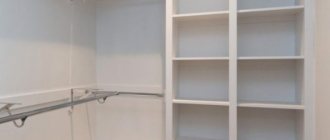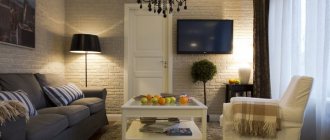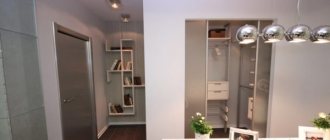Now it's time for the interior arrangement of the bathhouse! Shelves and benches, a table, a couch for relaxation and other furnishings must not only be selected correctly, but also correctly placed indoors so that they can be used conveniently and safely. Furniture for baths and saunas can be bought ready-made or ordered from a craftsman according to an individual sketch, but many people prefer to make it themselves. The best material for this is wood. If you have carpentry tools and basic skills in working with them, making furniture will not be difficult.
Wooden furniture for a bath
It’s quite easy to make bath furniture with your own hands
Choosing a tree for a bath
There are many types of wood, but not all of them are suitable for saunas and baths. There are certain requirements that the material must meet:
- low thermal conductivity;
- ease of processing;
- absence of cracks, knots and resin pockets;
- high density.
Conifers containing resins can only be used in the wash room, dressing room and recreation room, where there are no high temperatures. The exception is Canadian cedar, which has a low resin content and a very attractive texture. In all other cases, steam room furniture is made exclusively from hardwood - ash, linden, oak, aspen, poplar, alder and others.
Characteristics of wood
| Name | Color | Advantages | Flaws |
Pine | White, light yellow | The material is durable, good density, easy to process, affordable price | Releases resin when heated |
Spruce | Spruce White to reddish | Easy to process, has a beautiful texture, affordable | Highly susceptible to rotting, contains a lot of resin, a large number of knots |
Larch | Yellow | Beautiful texture, high density and strength, resistant to negative influences | Heavy, may crack during processing |
Oak | From light gray to brown | Beautiful texture, high strength, resistance to any aggressive influences | Heavy weight, requires effort when handling |
Ash | White to olive | Wear-resistant, not subject to cracking, bendable, has a beautiful texture | Sensitive to changes in humidity and temperature |
Poplar | Sandy, off-white | Easy to process and light weight | Prone to rotting |
Aspen | Light yellow | Easy to process and highly resistant to moisture | Wears out quickly and gets dark |
Alder | Pink to red-brown | Soft, light, easy to handle, moisture-resistant, does not deform or dry out, has a healing effect on the body | None |
Linden | Light beige | It has a pleasant aroma, has a healing effect, is easy to process, does not heat up, does not rot | None |
Canadian cedar | Reddish brown | Beautiful texture, high strength, very pleasant aroma, beneficial effect on the human body, does not rot | High price |
The wood must be dry, dense, without cracks or other defects, with a smooth surface. The higher quality the lumber, the longer the furniture will last. Raw boards are more difficult to process, and finished products become deformed when drying.
Texture of different types of wood
Prices for edged boards
edged boards
Choosing the right wood
It is important to carefully select wood for crafts. It must have a perfectly clean surface: without fungi, areas of rot, or obvious structural defects. In different rooms of the bathhouse there are different conditions of temperature and humidity, and only selected wood is able to withstand these difficult conditions for years. This is especially important for items that will be used in the steam room (wooden tubs, mugs, buckets).
To use items in the steam room, you should choose low-density wood, such as linden and alder.
The fact is that low-density material reduces the level of thermal conductivity of the product, and it can be safely picked up in the steam room. But for the decoration of the washing room it is better to choose denser wood. In both cases, it is desirable that the wood has a high content of resins, which increase its ability to withstand high humidity.
For wooden crafts I use the following types of wood:
- aspen;
- Linden;
- beech;
- alder;
- maple;
- pine.
Advantages and disadvantages of some types of wood used for making various bath crafts
| Breeds | pros | Minuses |
| Linden. | Good in the absence of viscous resin. This material is resistant to moisture and is able to absorb steam without negative consequences for appearance. The soft structure of linden can be easily processed by hand, and crafts made from it are distinguished by their low weight and low level of thermal conductivity. Another plus of linden is that it is resistant to high humidity, which allows you to use items made from it in a steam room. | The disadvantage of this wood is that over time, crafts made from it become dark, which not everyone likes. Therefore, linden is recommended to be used to create mugs, buckets and various wooden basins for baths. |
| Beech. | It is often used for bath crafts, as it is convenient to plan and process on a lathe. | But it is characterized by a low level of moisture resistance, as it is subject to severe warping from moisture. Therefore, it is better to place beech crafts in the dressing room. Even if you plan to keep them in rooms with low humidity, it would be a good idea to additionally treat the surface of the finished products with special protective oils and wax. |
| Alder. | It is considered a light and soft wood with a sticky texture. It is easy to process and sand, and alder crafts are famous for their velvet surface, very pleasant to the touch. | Not durable. |
| Maple. | It produces objects with a clean and smooth surface that is easy to process and tint. | But this wood is difficult to cut, so you will have to put in a lot of effort. |
| Pine. | Coniferous wood impresses with its availability and affordable price. She smells pleasantly of resin. | It is precisely because of the abundance of resin that it is inconvenient to work with. It can damage the paint layer, dull and clog cutting tools. |
In addition, pine has a striped structure, which may not be suitable for every product.
Types of furniture for baths and saunas
In addition to shelves, which are a mandatory piece of furniture, other furniture is also used in baths.
Furniture in the bathhouse
Carved bath lamp
Shelves, hangers, water containers
Sign – bath hanger
In the dressing room there are hangers and shoe stands, in the wash room there are comfortable benches or stools, in the rest room there is a table with benches and a couch, if the size of the room allows. Of course, the decisive role in choosing bath furniture is played by the preferences of the owners themselves: some like minimalism in the interior, others furnish the bathhouse with maximum comfort, taking into account every little detail.
Carved furniture - decoration and pride
Log bench
Table and benches in the bathhouse
Table and benches for the bath
The table in the bathhouse most often has a rectangular shape; its length and width are calculated taking into account the number of people who will be steaming at the same time. To save space, there are options for folding and folding wall tables, which you can also make yourself.
Folding table
Folding table - design
The most popular furniture is benches: people sit on them while washing and resting, put tubs and buckets on them, and sometimes even use them instead of shelves. They are made simple and with backs, wide, narrow, of various lengths.
Benches
Bath benches
Small bench
Bath bench
Additional attributes of the bath interior include hangers, footrests, and various shelves. Such furniture is small in size and easy to assemble, so making it is not at all difficult. If you use your imagination, you can give these products a very original shape.
Options for bath shelves
Log hanger
The main rule is that the furniture must be stable and have a thoroughly sanded surface so that splinters do not dig into the skin when sitting.
The dimensions of the furnishings depend on the area of the room: the smaller the bathhouse, the more compact the furniture. You should not overly clutter the space, because this is not only inconvenient, but also dangerous. It is recommended to make tabletops, backs and seats of benches, and stands not solid, but with small gaps for water drainage. This way the wood will dry out faster and last longer.
Choosing a table shape for a bath
Having selected the wood, draw up a drawing of the bathhouse table with your own hands. To create a durable and strong product, you need to decide on its shape and design:
- A round table can be installed in a bathhouse if you plan to place benches in the form of a corner or arrange chairs in a circle. This model is more suitable for large rooms.
- A product with a square or rectangular tabletop is placed under a wall or near a straight bench. This table is most popular because of its versatility.
- As for oval tables, you can rarely see them in a bathhouse. They are usually used to accommodate a large company.
- If the room in which the table will be located is large, then you can make a stationary structure on four legs. In this case, the table will be most stable.
- In a small room, an excellent way out of the situation would be to install a folding product on two legs or one wide support. They are usually designed to accommodate 2-4 people.
Tools for work
To make furniture yourself, you will definitely need a standard set of tools:
- hacksaw;
- a circular saw;
- Sander;
- set of cutters and hand router;
- drill with attachments or screwdriver;
- hammer;
- plane;
- pliers;
- clamps;
- square and tape measure;
- level.
Woodworking tools
Clamps
A circular saw
Level
For fastening you will need self-tapping screws, as well as metal corners. Experienced craftsmen make all connections without metal fasteners, using only wooden dowels. But such work requires skill and a lot of time, and with the help of self-tapping screws, furniture can be assembled much faster.
Metal corners
Furniture dowels
Prices for metal corners
metal corners
Making a table
1 way
For example, a rectangular table with cross-shaped legs is taken. This option is the easiest to implement, convenient to use, and takes up little space. This table seats 6 people freely.
Simple table
For work you will need the following materials:
- boards 30x145 mm and 40x250 mm;
- wooden slats 40x40 mm;
- screws and bolts;
- antiseptic primer.
Step 1. Boards 30x145 mm are cut so that you get 4 blanks 1.2 m long. Now you need to make oblique cuts on the blanks at an angle of 45 degrees, on both sides. Step back 10 cm from the ends, draw a line with a pencil to the corner of the board and saw off the excess. The cuts on each workpiece must be strictly parallel.
Preparing the table legs
Step 2. The workpieces are thoroughly sanded with a machine or sandpaper, the dust is swept away, treated on all sides with an antiseptic and dried.
Grinding
Step 3. The blanks are folded flat in pairs, crossing in the central part; the cut ends should be located in the same plane. After this, the legs are fixed with clamps and the locations of the fastening bolts are marked. There should be two bolts on each side - at the top and bottom of the intersection of the workpieces. Drill holes for fasteners.
Attaching the legs
Step 4. Bolt the workpieces and install the legs at a distance of 1.05 m from each other. Two spacers are made from the remaining 30x145 mm boards and screwed flat to the table legs, as shown in the diagram.
Bath table layout
Step 5. Blanks for the tabletop are cut from 40x250 mm boards - 3 pieces 1.75 m long. The blanks are processed with a grinding machine, impregnated with an antiseptic, and dried.
Step 6. The slats are cut into 2 pieces 77 cm long and also treated with a primer.
Bioprotective primer
Lay the blanks for the tabletop on a flat surface, face down, and connect them with crossbars made of slats using self-tapping screws.
Step 7. The tabletop is lifted, turned over and placed on top of the legs. The upper sections of the legs should fit snugly against the crossbars of the tabletop on both sides of the table. The structure is fixed with self-tapping screws.
The table is ready, you can bring it into the bathhouse and use it. For greater decorativeness, the edges of the tabletop can be made semicircular using a jigsaw.
The table top is visible, the edges of the boards are chamfered
Prices for wood primer
wood primer
Method 2
If the bathhouse will be used by no more than 3 people at a time, you can make a small wall table that takes up almost no space.
Wall table in the bath
To work you will need:
- 5 boards 30x200 mm 80 cm long;
- block 40x50 mm, 1 m long;
- 2 bars 40x50 mm, 75 cm long;
- self-tapping screws
Step 1. Choose a suitable place for the table, for example, near the wall under the bathhouse window. At a height of 70-80 cm from the floor, a mark is placed on the wall. Now, using a level, draw an even horizontal line along this mark, on which the width of the tabletop is marked.
Step 2. Boards and bars are treated with a sanding attachment on all sides, then primed and dried.
Step 3. Assemble the tabletop from the boards: the boards are laid in a row on a flat surface, leveled, fastened with crossbars made of 75 cm bars. One bar is screwed at a distance of 7 cm from the edge of the boards, the second is flush with the ends on the other side of the table top.
Step 4. The finished tabletop is applied to the wall at the level of the markings so that the crossbar fits tightly to the surface. Screw it in with self-tapping screws.
Step 5. Next, you need to install a support: the beam is placed under the edge of the tabletop so that it rests against the lintel from the inside, and its lower end is placed against the wall. Use a marker to mark the locations of the cuts, remove the beam and cut its ends at an angle of 45 degrees so that the cuts fit tightly to the surfaces of the table and wall. After this, the support is finally installed in place and fixed with self-tapping screws.
Drawing of a folding table
Folding table assembly diagram
Semicircular folding table
Semicircular folding table when folded
Table top cut out
Table support cut out
Drilling holes
Plate that will be attached to the wall
Connection of plate to support
Table assembly
Hinges for tilting the table cover
Fixing the table
Prices for timber
timber
Bath furniture design
And, of course, we must not forget about the appearance, because furniture should be not only functional, but also beautiful. You can choose a set whose design will appeal to your household and guests, or you can decorate the room in a certain style and purchase a furniture set to match it.
Furniture in Provence style
Purely wooden furniture is rare in Provence, so it is better to decorate a recreation room in this style.
Provence is a simple French style in which it is good to create a relaxation room. The furniture is usually made of light wood, there is a white tablecloth on the table, and the chairs and sofa are upholstered in soft fabric with small flowers. Forged elements are used - backs and legs. You can put somewhere (it’s better to hang) a wicker rattan chair with a soft floral pillow. It is very important not to overload the room.
Rustic style furniture
Rustic style is maximum simplicity, knots and untreated wood.
Antique wooden furniture for a bathhouse looks especially good if done in a rustic style. It looks interesting in the photo, looks original and unusual.
The furniture should be made of solid wood, the main idea is “off-scale” simplicity. All items are rough, knocked together, there are traces of bark on them, knots protrude, but at the same time the products are comfortable and reliable.
Wooden chairs for baths
You can find and process a small stump and use it to make a stool for the washroom or one of the chairs for the rest room.
Country style furniture
Country is a style characterized by simplicity and good quality.
Country is a direction of the American village, in which the manufacture of furniture has always been the responsibility of the owners of the house. As a result, it should be of high quality, but simple. No carvings or chairs with embossed backs. The maximum permissible treatment is to plaster and varnish.
Barrels for Japanese baths
However, textiles are welcome. In country, it has bright natural colors. These could be cushions that replace seats on chairs in the rest room, or a rug in the dressing room. Furniture is usually chosen in a warm brown shade or a light yellow color.
Chalet style furniture
Chalet is a style that loves carvings and aged furniture.
Chalets are an old style of Swiss mountain houses. Here you need to age the piece of furniture and varnish it (before bringing it into the bathhouse). Carving is welcome; in the relaxation room you can place a huge sofa covered in leather or warm plush. The main idea of a chalet (regardless of whether it has a gazebo, a whole house or a steam room) is comfort without unnecessary complications.
Furniture in Russian style
Russian style is light wood, simple shapes and traditional painting.
In the Russian style, one cannot do without a whitewashed stove and rough-looking tables and benches. The color of the furniture should be light yellow, the walls should be made of logs or covered with wood. In the dressing room, instead of a closet, a large chest is placed, and in the rest room, carved shelves with craft items are mounted on the wall.
Shelves in the bath
Paintings of traditional Russian styles are welcome: red and black majolica, white and blue Gzhel, bright, fluffy Khokhloma flowers. The main thing is not to overload the room with accents and leave most of the furniture unpainted. It’s good if the main material is oak or pine.
Sauna bench
In the wash room there will be a wide bench to wash with all the amenities. As an example, one of the simplest drawings of a bench is presented.
Sauna bench
Sauna bench - drawing
During the work you will need:
- 3 boards 30x120x1500 mm;
- 2 wooden planks 1460x10x20 mm;
- 2 boards 420x260x30 mm;
- 1 board 1240x30x200 mm;
- wood glue;
- self-tapping screws
Step 1. Take one board 1500 mm long, lay it flat on the work table and secure it with clamps. Using a cutter, a longitudinal groove 10 mm deep is cut in the side surface for the entire length of the board. Exactly the same groove is made on the second board, and on the third board grooves are cut out on both sides.
Step 2. The milled boards are again laid on the work surface in a row, with a board with two grooves in the middle. All grooves and both planks are coated with glue, after which the planks are inserted into the holes, firmly connecting the boards into a shield, and the product is clamped with clamps.
Assembling the shield for the bench
Step 3. While the seat panel is drying, cut out the sides with a jigsaw. On the sides and in the lower part it is enough to make semicircular cutouts with a depth of 50 mm, and at the top, exactly in the middle of the workpiece, you need to select a groove for a longitudinal beam measuring 100x30 mm. To do this, first take preliminary measurements and mark the cutout lines with a pencil. The second sidewall is made in exactly the same way.
Step 4. Prepare a longitudinal beam: take a board 1240 mm long, lay it flat on the work table, measure 10 cm on each side and draw 2 parallel lines across the workpiece with a pencil. From the middle of the line a perpendicular is drawn to the end of the board and the resulting square is cut out with a hacksaw. On the other side they do the same. The result should be a workpiece with two protrusions, which can be rounded with a jigsaw for greater decorativeness.
Step 5. The sidewalls and longitudinal beam are ground, the cut edges are processed with a radius molding cutter. Next, all elements of the future bench are primed with an antiseptic composition and dried.
Step 6. Assemble the bench: the protrusions of the longitudinal beam are threaded into the grooves on the sides, fastened with screws on the sides. The seat panel is placed on top, aligned in the center, screwed with self-tapping screws along the line of connection with the longitudinal beam and to the upper ends of the sidewalls.
Bench assembly diagram
Prices for PVA glue for wood
PVA glue for wood
Footrest
You will need 5 planks 600x70x20 mm, 2 planks 400x70x20 mm and a block 50x50 mm for making the legs.
Footrest
Footrest for bath
Step 1. Well-polished planks 600 mm long are laid out in a row on a flat surface. Gaps of 10 mm are left between the slats and aligned along the length.
Step 2. Place two transverse planks on top, placing them along the edges of the planks, flush with the ends. The product is secured with screws.
Step 3. The block is cut into pieces 3-4 cm high; these will be the legs for the stand. They are applied to the transverse strips at the corners and secured with screws. Finally, treat the stand with stain or colorless wood primer.
You can make the stand not with a straight surface, but with a rounded one, which is much more comfortable for the feet. How to do this is detailed in the video.
Video - making a footrest
Bath hanger
Option 1
Bath hanger
To create a hanger you will need:
- flat board 400x20 mm and 50 cm long;
- 4 wooden knots with a Y-shaped branching with a diameter of 30 mm;
- plane;
- sandpaper;
- drill;
- stain;
- screws, nails or wooden dowels for fastening.
Branches should be chosen that are strong, with a dense texture, and without traces of rot. It is not necessary to look for knots of the same shape, the main thing is that they match in thickness. The length of the workpieces should not exceed 30 cm, and the length of the branches should not exceed 3-4 cm. The bark from the branches must be removed, and the workpieces are thoroughly dried in the shade.
Branches
Step 1. Each workpiece is planed on one side with a plane along the entire length to approximately ¼ of the thickness of the branch. This side of the branches will be attached to the base.
Sanding a branch
Attaching branches
Step 2. The ends of the branches on the workpieces are treated with sandpaper, rounding off the cuts.
Branch arrangement option
Step 3. The board is sanded, then covered with stain along with the branches and dried.
Step 4. Lay out the knots on the board and mark the attachment points with a pencil. If wooden dowels are used as fasteners, 2 holes are drilled on the smooth side of the workpieces - bottom and top at a distance of 5 cm from the ends of the branches.
Step 5. Holes for dowels 2 cm deep are also drilled in the board according to the markings, after which the branches are fastened to the base. When using nails or self-tapping screws, the caps are recessed into the wood by 1-2 mm, and then covered with heat-resistant putty to match the color of the wood.
Prices for stain
wood stain
Option 2
Bath hanger diagram
To work you will need:
- 3 boards 1120x100x20 mm;
- 6 boards 1500x120x20 mm;
- 1 board with a section of 200x20 mm for the shelf and sides;
- self-tapping screws 35 mm;
- wooden dowels 10x30 mm;
- wood plugs;
- stain;
- sandpaper;
- hacksaw;
- jigsaw;
- drill;
- hammer;
- tape measure and square;
- pencil;
- hooks
The manufacture of such a hanger is carried out in three stages: first, the frame is assembled, then a holder for hooks is made, and the shelf is attached last in the upper part of the frame.
Step 1. The wood is thoroughly sanded with sandpaper or a sanding attachment. Boards 1500 mm long are laid out on a flat surface parallel to each other, leaving a distance of 8 cm between them. The edges are aligned.
Sanding wooden boards with sandpaper
Step 2. Fasten the future frame of the hanger with three horizontal crossbars made of boards 1120 mm long. The upper cross member is located flush with the ends of the boards, the other two - in increments of 50 cm. All frame elements must be perpendicular. The screws are screwed in from the side of the crossbars, recessing them slightly into the wood.
Step 3. Start making a holder for hooks: cut a piece 1070 mm long from a 200x20 mm board, sand the ends. Now you need to secure the holder to the frame, but the hooks can be screwed in after installing the hanger.
Step 4. The holder is placed under the frame, laid parallel to the top crossbar at a distance of 10 cm from the top of the structure. Fasten with self-tapping screws, screwing 2 into each vertical board. This fixation of the holder gives the frame additional rigidity.
Step 5. From the remaining board, cut out a shelf 1070 mm long and cut out two side panels with a jigsaw, as in the diagram. All cuts must be sanded. Next, markings are made for the dowels: with a pencil, they mark the lines where the shelf fits to the sidewalls and the sidewalls to the frame boards, and points are placed on the lines for drilling holes.
Fastening the shelf and sides
Step 6. Drill holes according to the markings, insert dowels into the shelf, attach the shelf to the sides, and then to the frame itself. Additionally, the shelf is secured on the sides with self-tapping screws, the heads of which are covered with plugs.
Step 7. Determine where the hanger is attached to the wall, drill holes for fasteners in the wall and cross boards, install and fix the hanger.
Attaching the hanger to the wall
Unusual hooks made from forks
Coat hook made from a key
Classic coat hooks
Forged hooks
This is how you can furnish your bathhouse or sauna with homemade furniture. All the examples are quite simple, so even a novice master can cope with them. And even if everything doesn’t work out perfectly, hand-made furniture will make your stay in the bathhouse much more enjoyable!
Similar hanger design, assembled in the same way
Video - Furniture for baths and saunas made of wood
Classification
Tables for a bath can be divided into separate groups depending on various factors: material, type of general design, shape of furniture.
By design
Depending on this criterion, 3 types of tables can be distinguished:
- Classic rectangular. The legs are located parallel to each other.
- V-shaped. The legs rest on a horizontal beam that lies on the floor. They connect at one point, from where they diverge to different corners of the tabletop.
- X-shaped. The legs cross each other. They are connected by inserting into cut-out recesses.
Classic tables with parallel legs can be divided by the number of supports - from 1 to 4.
By shape
Varieties:
- With a round tabletop. Several bath attendants can gather around them at the same time, depending on the size. Due to the lack of corners, useful space disappears; such a shape is more difficult to make yourself.
- With an oval tabletop. They are similar to round ones in terms of operation and the difficulties of self-assembly, but they take up even more usable space.
- Rectangular, square. Especially popular among bath attendants. They are easy to make yourself.
A separate group of tables are polygons. They have low popularity because they are only suitable for large rooms.
